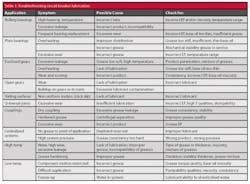The purpose of lubrication is to reduce friction between moving metal surfaces. Lubricating grease must wet the metals and resist being displaced by the pressures it encounters if it is to keep metal surfaces separated. A lubricant also can serve as a coolant, prevent corrosion and block the entry of contaminants. Satisfactory grease also will resist breaking down by separating into its constituent components, be reasonably stable and not change its nature significantly within the temperature range for which it was designed. Good grease flows easily into bearings when applied under pressure and remains in contact with moving surfaces. It won’t leak through gravitational or centrifugal action, nor will it stiffen in cold temperature and thereby unduly resist motion.
|
View related content on PlantServices.com |
Three primary considerations that go into the blending of grease are the liquid lubricant (petroleum or synthetic fluid), the thickening agents and the additives. The grease must be heavy enough to provide film strength, yet light enough to flow well in cold temperatures. Investigate which solid or liquid additives, such as the extreme pressure (EP) type, will do the best job. For example, the grease for open gears needs a tacky additive to keep it in place. A manufacturer might specify the type of grease to be used in its equipment. In any case, follow these special precautions:
Clean out old lubricant: Before applying new lubricant, remove all traces of the old lubricant with commercial cleaners, kerosene, mineral spirits or other solvents. Soak the disconnected parts in solvent to loosen the old lubricant. Agitate or flush solvent through the parts to remove contamination. If the parts can’t be removed, adding oil might be helpful, but it’s important to use the same type of oil that was used as a base in grease to be removed. Use a soft-bristled brush to speed the cleaning process. Then, carefully dry the parts and relubricate them as soon as possible.
Never use penetrating oil on electrical equipment: It’s not designed to lubricate. Penetrating oils are only for rust removal and ease of part disconnection. They always contain one or more solvents. Penetrating oil works only briefly, is contaminated easily and can change into a viscous mess. In comparison with grease at ambient temperatures, penetrating oil has a much lower viscosity (flows easily), a very low boiling point and high vapor pressure. It leaks out under gravity or centrifugal action, leaving parts unlubricated. Penetrating oil can attack, dissolve and wash out factory-installed lubricants, which hasten failure. Most penetrating oils or aerosols are flammable and shouldn’t be applied in areas where sparks or arcing might occur.
Choose lubricants carefully
The general rule is to avoid graphite, molybdenum disulfide (moly) and PTFE (Teflon) lubricants for electrical contacts because those products can cause a resistance rise after multiple contactor cycles. Never lubricate electrical contacts with a metal-filled lubricant unless its use has been tested and proved to be effective in the long term. Many such materials accelerate corrosion, introduce conductive paths and eventually cause failure. Depending on the application, manufacturers might specify multiple grease choices, which have been tested thoroughly for a specific application.
Some OEMs specify Mobil Temp SHC 32 and Mobilgrease 28 from ExxonMobil. Another OEM recommends Dow Corning BG-20 for primary and secondary disconnects in low-voltage switches. The silver-filled lubricant Conducto-Lube from Cool-Amp Co. has a long application history for lubricating exposed contacts of disconnect switches.
If the switch operates only infrequently, keeping the contact clean, dry and unlubricated might be a viable option. In fact, never lubricate main disconnects and arcing contacts. Proper lubrication practices for various types of low-voltage and medium-voltage power distribution equipment are enshrined in the proceedings of many technical conferences and in OEMs’ service bulletins.
Troubleshooting circuit breaker lubrication
Use the troubleshooting guidelines provided by the circuit breaker’s manufacturer. If that troubleshooting procedure is unavailable or ineffective, consider using diagnostic instruments that measure trip time, force, resistance, vibration and other relevant variables to determine if the diagnostic profile indicates lubrication problems. In the absence of such diagnostic help, consider slow breaker operation to be indicative of inadequate lubrication. Typical lubrication-related symptoms, problems and solutions are shown in Table 1.
Lubrication recommendations for electrical equipment
OEM specifications: Lubricate according to the manufacturer’s specification, if alternative lubrication practices aren’t being used. If the lubricant is obsolete or the manufacturer no longer serves the market, you can’t possibly follow the OEM’s lubrication specification. In such case, your lubricant choice must be based on the application and physical properties of candidate greases.
Change of lubricant: Any lubricant change often involves testing and must be performed under engineering supervision. The engineering staff should specify the type and brand of grease or oil to be applied during maintenance or overhaul of a particular piece of equipment. Analyze any equipment failure that might be caused by insufficient lubrication. Use experience and judgment to improve lubrication technique and lubricant choice.
Lubricant availability: Any lubricant chosen must be readily available locally and nationwide. Keep a sufficient supply of greases in properly organized storage together with the corresponding MSDS and technical data sheets.
Lubrication in field: When disassembly isn’t possible, use low- or medium-viscosity oil. In some cases, the characteristics of petroleum oils might be improved by adding a stable dispersion of molybdenum disulfide in a premium mineral oil. An example of such product is DCM, manufactured by Dow Corning, which might extend lubricant and gears life, reduce metal-to-metal contact, lowers friction and provide other benefits. It might also be used as a lubricant concentrate.
Dr. Bella Chudnovsky is a staff mechanical engineer for Square D Services, West Chester, Ohio, and can be contacted at [email protected] and (513) 755-4249.

